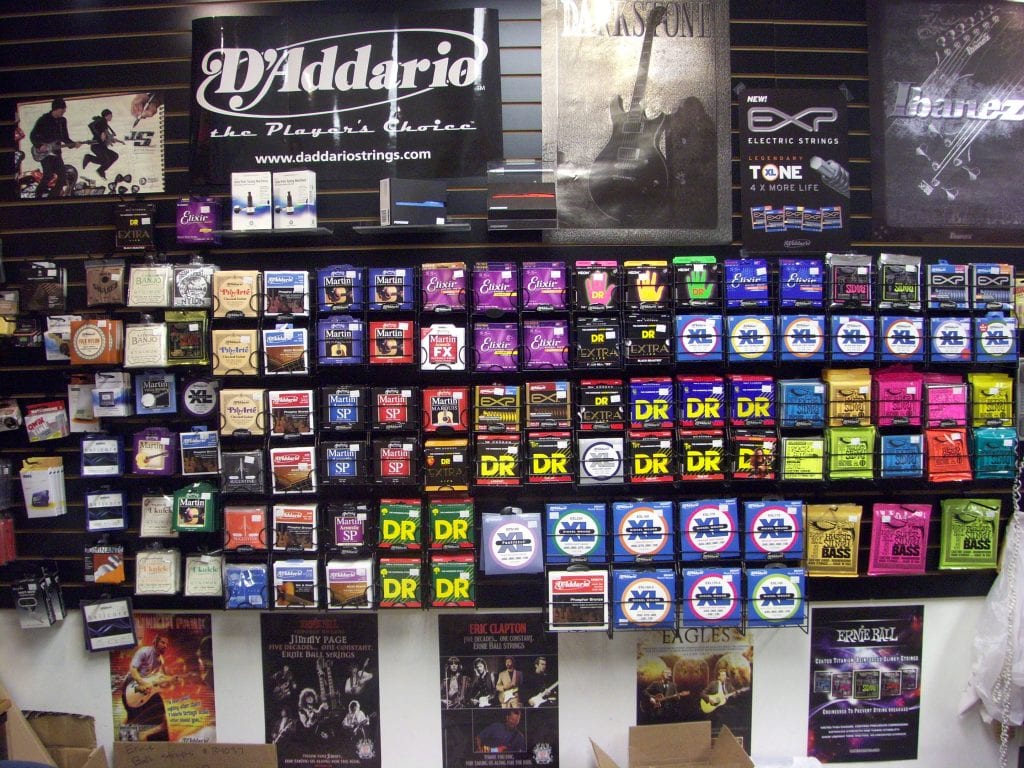Buying Guitar Strings
One of the best parts of my job as a sales associate at Murphy’s Guitars in Utah is helping people find the exact tone that they’re looking for. Some customers find it right away and walk out of the store with huge smiles on their faces. Eventually I know that they’ll be back, first of all because I’m committed to giving my customers exceptional service, but secondly everyone will eventually need to change their strings. Today I’m going to walk you through searching for the perfect pack of strings.
Electric, Acoustic, or Classical?
When a customer walks in and says, “I need guitar strings” It’s basically a game of 20 questions. Start with general questions, and filter it down to the most specific. The first question that I will ask 100% of the time is, “are these for an Electric, Acoustic, or Classical Guitar?” Seems easy enough, but just to be sure…
Acoustic
Also called a “steel string” acoustic, if your strings 3rd-6th strings are a gold or brown and the top two are steel, you’ve likely got an acoustic guitar on your hands, however if you’re not entirely sure, and think you might have a classical guitar (which acoustic guitar strings would damage) loosen the strings immediately and take it to your local shop, they’ll help you identify it.
A “steel string” acoustic guitar will use either a phosphor bronze or 80/20 bronze strings. Other options do exist, but these two types are the most common.
80/20 Bronze
I’ll often ask the customer if they prefer a brighter sound that works well with finger picking, country, bluegrass, or if the specific tone that they are looking for is brighter and more vibrant. These are your 80/20 bronze strings. These are lighter in color than their phosphor bronze counterparts (a golden wheat color), and also sound much brighter, and more alive. 80/20 bronze strings will normally be cheaper or the same price as phosphor bronze, and are produced by nearly any string manufacturer.
Phosphor Bronze
Darker color (darker golden honey) and a darker tone, phosphor bronze strings produce a dark, warm, rich, projecting tone, and although they come in the same gages as 80/20’s they will often excerpt more pressure on the guitar, therefore creating a more projecting tone.
Electric
Electric guitars are the easiest to identify, but there are a few factors that will be important in selecting strings. Does your guitar have a tremolo system of some sort? Do your strings pass through the body or through a tailpiece? What size of strings are you currently playing with? All of these questions will be important later when we discuss electric guitar strings in greater depth.
Electric guitar strings are made in a multitude of ways, different alloys, different winding techniques, and perhaps the biggest difference is the wide varieties of sizes. How do you choose just one?
Size
First I’d suggest looking at size. Your local shop, even the big box stores can’t carry every brand, size, and shape of strings on the market. They might only have the right size in one or two brands, so pick your size, then move on.
The string sizes are often referred to by the diameter of the smallest string, or in some cases the smallest string and the thickest string. (9’s, or “10-52”)
7’s and 8’s- many shops won’t even carry 7’s, the most notable player that uses 7’s is Billy Gibbons from ZZ top, 7’s and 8’s are extremely light, and for most players don’t create enough tone and sustain. The most noticeable advantage to 7 or 8 gauge strings is the light feel, and the smooth, easy bending.
9’s- 9’s are the most common strings. Fender guitars, guitars with a Floyd Rose tremolo system, and many others come out of the factory sporting 9 gauge strings. Any player looking for a light feeling string that is easy to bend should look into a set of 9’s.
10’s- most guitars with a tailpiece, strings that go through the body, and many others will use 10 gauge strings. Slightly heavier than the 9’s, but the sacrifice in playability is made up in tone and sustain.
11’s, 12’s, 13’s and more- Heavier gauges serve a multitude of purposes, the most common being either creating more tone and sustain for players like blues legend Stevie Ray Vaughn, and making up for the tension that is lost in drop tuning found commonly in rock, grunge, and metal. If you’re thinking about making the change to a heavier string, consult your local guitar tech first. Often times your guitar will need some adjustments to keep it in optimal playing condition.
Flat wound, half round, pure nickel, nickel-plated steel, stainless steel, and others?
Electric Guitar strings come in a multitude of materials, but the easiest way to understand how each of them will affect your tone is with a simple warm to bright spectrum. The string gauges are arranged as:
Flat wound, half round, pure nickel, nickel-plated steel, stainless steel
Ranging from darkest (flat wound) to brightest (stainless steel)
The most common strings are the nickel-plated steel. Many companies also add other materials to the mix such as Cobalt, Titanium, and others. Research the choice, or just try them out, and see if any of these work for you.
Coated Vs. Uncoated
Both electric and acoustic strings can be “coated” or “uncoated” (plain). Coated strings are covered in some sort of corrosion resistant material. A coated string will normally last you a few months longer, and are great options for players like me that have sweaty hands, and play often. Many of the coated strings will sound somewhat “dead” out of the package, but will maintain a more consistent sound over a longer period of time.
Classical
The last option is a classical guitar. Classical guitars have wound 4th, 5th, and 6th, (D,A,E) strings, which are often mistaken for “metal,” but they actually have silk cords running inside of them, which makes the strings smooth to play, and extremely flexible. The top 3 strings are usually a transparent nylon (often mistaken for plastic), but will sometimes be white, black, or some other color.
These guitars need to be strung with some form of nylon string. Trying to string a classical guitar with electric or acoustic strings will likely severely damage the instrument.
Classical strings come in a variety of materials and mixes, but will range from low tension to high tension. Just like acoustic and electric, a higher tension means harder to play, but better tone and sustain, and lower tension means easier to play, but less tone and sustain.
Final tips for buying guitar strings
Find a sales associate that knows his or her strings! These are people that work with these strings daily, they get feedback from other customers, and get the whole sales pitch from the company. Find someone that is knowledgeable, and that you trust for advise on strings.
If you don’t know how to put your strings on, ask for some help! Many shops offer stringing services, but most employees are glad to let you watch and give you some tips. Some companies also offer tools and systems to help you learn how to restring.
Keep the box in your case with the receipt, or write the date on the box in marker. Don’t you hate it when you can’t remember what you put on there last time? Keep the box in the case so if you hated the strings you don’t make that mistake again, and if you loved them, you know what to get next time. Then, keep the receipt in the case so that you know when they were purchased, or write on the box what day you put them on. This will help you track how long those strings lasted.
thanks for reading this guide to buying guitar strings
if you have questions feel free to contact us at Mail@MurphysGuitars.com
by phone: 801-298-4777
or visit us on social media!


